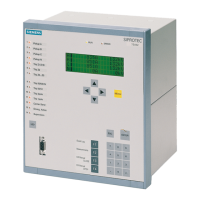2 Functions
144
7SD610 Manual
C53000-G1176-C145-4
erating with a synchronism check device, a longer dead time may be tolerated under
certain circumstances. Longer three-pole dead times are also possible in radial net-
works.
For AR control mode = with PICKUP ... it is possible to make the dead times
dependent on the type of fault detected by the initiating protection function(s).
Table 2-6 AR control mode = with PICKUP ...
If the dead time is to be the same for all fault types, set all three parameters the same.
Note that these settings only cause different dead times for different pickups. The trip-
ping can only be three-pole.
If, when setting the reaction to sequential faults (see above at „General“), you have set
address 3407 EV. FLT. MODE starts 3p AR, you can set a separate dead time
for the three-pole dead time after clearance of the sequential fault 1.AR: Tdead EV.
(address 3458). Stability aspects are also decisive here. Normally the setting con-
straints are similar to address 3457 1.AR Tdead3Trip.
Under address 3459 1.AR: CB? CLOSE it can be determined whether the readiness
of the circuit breaker ("circuit breaker ready") is interrogated before this first reclosure.
With the setting YES, the dead time may be extended if the circuit breaker is not ready
for a CLOSE–TRIP–cycle when the dead time expires. The maximum extension that
is possible is the circuit breaker monitoring time; this time was set for all reclosure
cycles under address 3409 CB TIME OUT (see above). Details about the circuit
breaker monitoring can be found in the function description, Section 2.10, at margin
heading „Interrogation of the Circuit Breaker Ready State“.
If there is a danger of stability problems in the network during a three-pole reclosure
cycle, set address 3460 1.AR SynRequest to YES. In this case a check is made
before each reclosure following a three-pole trip whether the voltages of feeder and
busbar are sufficiently synchronous. This is only done on condition that either the in-
ternal synchronism and voltage check functions are available, or that an external
device is available for synchronism and voltage check. If only single-pole reclose
cycles are executed or if no stability problems are expected during three-pole dead
times (e.g. due to closely meshed networks or in radial networks), set address 3460
to NO.
2nd to 4th reclosure
cycle
If several cycles have been set in the configuration of the scope of protection func-
tions, you can set individual reclosure parameters for the 2nd to 4th cycles. The same
options are available as for the first cycle. Again, only some of the parameters shown
below will be available depending on the selections made during configuration of the
scope of protection functions.
For the 2nd cycle:
3453 1.AR Tdead 1Flt is the dead time after single-phase pickup,
3454 1.AR Tdead 2Flt is the dead time after two-phase pickup,
3455 1.AR Tdead 3Flt is the dead time after three-phase pickup.
3461 2.AR: START Start in 2nd cycle generally allowed
3462 2.AR: T-ACTION Action time for the 2nd cycle
3464 2.AR Tdead 1Flt Dead time after single-phase pickup
3465 2.AR Tdead 2Flt Dead time after two-phase pickup
3466 2.AR Tdead 3Flt Dead time after three-phase pickup
3467 2.AR Tdead1Trip Dead time after single-pole tripping
www . ElectricalPartManuals . com

